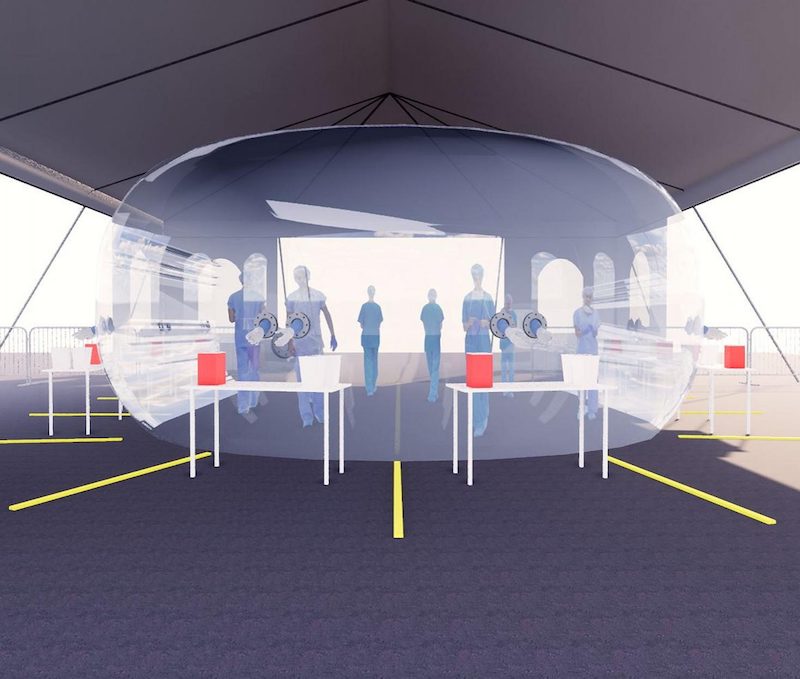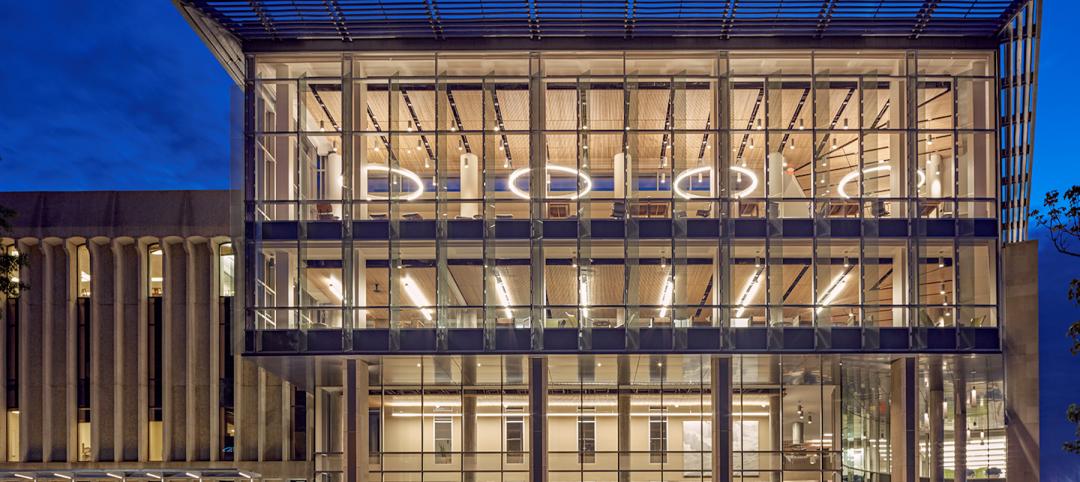A thorny issue shaping the current public health crisis is broad access to COVID-19 testing. If we could conduct wide-scale testing, we would be able to pinpoint the carriers and contain the spread of the infection. Yet testing has not been keeping pace with the growing contagion. Healthcare providers still face a dire shortage of adequate personal protective equipment (PPE), leaving clinicians on the front lines vulnerable to exposure.
To tackle this challenge, we participated in a rapid design competition organized by the Regional Partnering Center in Tucson, Arizona. Collaborating with a multidisciplinary team ranging from clinicians and engineers to materials scientists invited by the University of Arizona, we developed a unique design concept: a testing booth that allows healthcare workers to administer tests without using PPE or being exposed.

We reimagined a premanufactured inflatable structure, shaped like a bubble and intended for pool covering, as a testing booth. The “Bubble” consists of fiber-reinforced vinyl, which acts as a protective layer, fully separating healthcare workers who are inside the structure administering the tests, from those being tested, who stand outside. The transparency of the vinyl allows them to interact in a similar way as being in the same room. The pressure of the air pumped inside to inflate the structure works to both keep it in place and stop infection particles from making their way inside. And the vinyl material enables regular cleaning and sanitation.
The pneumatic structure is equipped with glove ports. Once the testing is completed, the specimens are left in designated areas. After the people who were tested have left, they are collected and taken to the lab.

The best part—the “Bubble” is light, sturdy and cost-effective. It can withstand extreme weather conditions and can be deployed quickly to parking lots or as self-standing healthcare facilities. As the design of our concept advances, we hope to share it widely soon.

More from Author
Shepley Bulfinch | Aug 12, 2024
Planning for growing computer science programs
Driven by emerging AI developments and digital transformation in the business world, university computer science programs are projected to grow by nearly 15% by 2030.
Shepley Bulfinch | Jul 11, 2024
3 considerations for designing healthy, adaptable student dining
Amanda Vigneau, IIDA, NCDIQ, LEED ID+C, Director, Shepley Bulfinch, shares three ways student dining facilities have evolved to match changes in student life.
Shepley Bulfinch | Nov 27, 2023
7 ways multifamily designers can promote wellness in urban communities
Shepley Bulfinch's Natalie Shutt-Banks, AIA, identifies design elements that multifamily developers can use to maximize space while creating a positive impact on residents and the planet
Shepley Bulfinch | Jul 6, 2023
The responsibility of adapting historic university buildings
Shepley Bulfinch's David Whitehill, AIA, believes the adaptive reuse of historic university buildings is not a matter of sentimentality but of practicality, progress, and preservation.
Shepley Bulfinch | Jun 2, 2023
Designing a pedestrian-focused city in downtown Phoenix
What makes a city walkable? Shepley Bulfinch's Omar Bailey, AIA, LEED AP, NOMA, believes pedestrian focused cities benefit most when they're not only easy to navigate, but also create spaces where people can live, work, and play.
Shepley Bulfinch | Apr 5, 2023
Carole Wedge, former Shepley Bulfinch President and CEO, retires after 37 years
Wedge’s 37-year career at Shepley Bulfinch evolved a historic firm into a national design practice.
Shepley Bulfinch | Aug 8, 2022
The technology balancing act
As our world reopens from COVID isolation, we are entering back into undefined territory – a form of hybrid existence.
Shepley Bulfinch | Jul 26, 2022
Better design with a “brain break”
During the design process, there aren’t necessarily opportunities to implement “brain breaks,” brief moments to take a purposeful pause from the task at hand and refocus before returning to work.
Shepley Bulfinch | Jul 11, 2022
Student life design impacts campus wellness
As interior designers, we have the opportunity and responsibility to help students achieve deeper levels of engagement in their learning, social involvement, and personal growth on college campuses.
Shepley Bulfinch | Jun 8, 2022
Welcome to the hybrid library
Libraries have grown to become the intellectual and social hubs of campus, where, prior to March 2020, students, researchers, and faculty gathered to collaborate and connect.
















